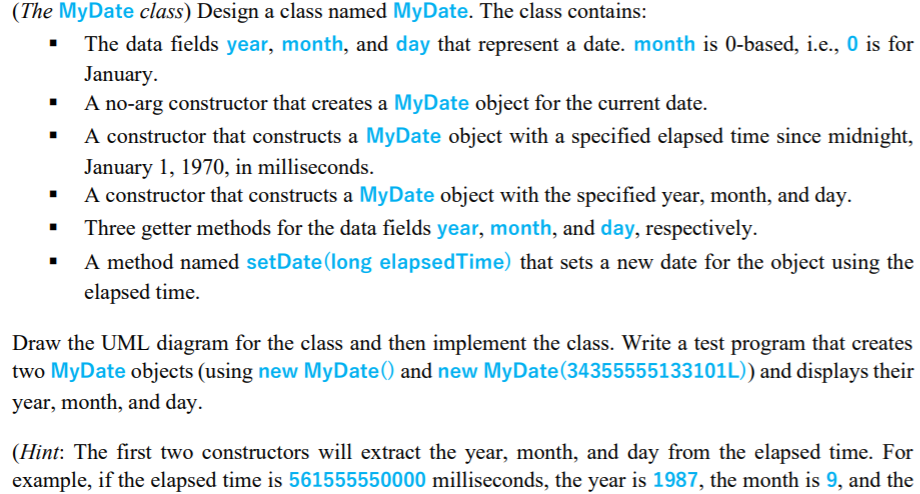(The MyDate class) Design a class named MyDate. The class contains: The data fields year, month, and day that represent a date. month is 0-based, i.e., 0 is for January. A no-arg constructor that creates a MyDate object for the current date. A constructor that constructs a MyDate object with a specified elapsed time since midnight, January 1, 1970, in milliseconds. A constructor that constructs a MyDate object with the specified year, month, and day. Three getter methods for the data fields year, month, and day, respectively. A method named setDate(long elapsedTime) that sets a new date for the object using the elapsed time. Draw the UML diagram for the class and then implement the class. Write a test program that creates two MyDate objects (using new MyDate() and new MyDate(34355555133101L)) and displays their year, month, and day. (Hint: The first two constructors will extract the year, month, and day from the elapsed time. For example, if the elapsed time is 561555550000 milliseconds, the year is 1987, the month is 9, and the
(The MyDate class) Design a class named MyDate. The class contains: The data fields year, month, and day that represent a date. month is 0-based, i.e., 0 is for January. A no-arg constructor that creates a MyDate object for the current date. A constructor that constructs a MyDate object with a specified elapsed time since midnight, January 1, 1970, in milliseconds. A constructor that constructs a MyDate object with the specified year, month, and day. Three getter methods for the data fields year, month, and day, respectively. A method named setDate(long elapsedTime) that sets a new date for the object using the elapsed time. Draw the UML diagram for the class and then implement the class. Write a test program that creates two MyDate objects (using new MyDate() and new MyDate(34355555133101L)) and displays their year, month, and day. (Hint: The first two constructors will extract the year, month, and day from the elapsed time. For example, if the elapsed time is 561555550000 milliseconds, the year is 1987, the month is 9, and the
C++ for Engineers and Scientists
4th Edition
ISBN:9781133187844
Author:Bronson, Gary J.
Publisher:Bronson, Gary J.
Chapter2: Problem Solving Using C++using
Section2.5: Variables And Declaration Statements
Problem 6E
Related questions
Question

Transcribed Image Text:(The MyDate class) Design a class named MyDate. The class contains:
The data fields year, month, and day that represent a date. month is 0-based, i.e., 0 is for
January.
A no-arg constructor that creates a MyDate object for the current date.
A constructor that constructs a MyDate object with a specified elapsed time since midnight,
January 1, 1970, in milliseconds.
A constructor that constructs a MyDate object with the specified year, month, and day.
Three getter methods for the data fields year, month, and day, respectively.
A method named setDate(long elapsedTime) that sets a new date for the object using the
elapsed time.
Draw the UML diagram for the class and then implement the class. Write a test program that creates
two MyDate objects (using new MyDate() and new MyDate(34355555133101L)) and displays their
year, month, and day.
(Hint: The first two constructors will extract the year, month, and day from the elapsed time. For
example, if the elapsed time is 561555550000 milliseconds, the year is 1987, the month is 9, and the
Expert Solution
This question has been solved!
Explore an expertly crafted, step-by-step solution for a thorough understanding of key concepts.
This is a popular solution!
Trending now
This is a popular solution!
Step by step
Solved in 6 steps with 3 images

Knowledge Booster
Learn more about
Need a deep-dive on the concept behind this application? Look no further. Learn more about this topic, computer-science and related others by exploring similar questions and additional content below.Recommended textbooks for you

C++ for Engineers and Scientists
Computer Science
ISBN:
9781133187844
Author:
Bronson, Gary J.
Publisher:
Course Technology Ptr

C++ Programming: From Problem Analysis to Program…
Computer Science
ISBN:
9781337102087
Author:
D. S. Malik
Publisher:
Cengage Learning

C++ for Engineers and Scientists
Computer Science
ISBN:
9781133187844
Author:
Bronson, Gary J.
Publisher:
Course Technology Ptr

C++ Programming: From Problem Analysis to Program…
Computer Science
ISBN:
9781337102087
Author:
D. S. Malik
Publisher:
Cengage Learning